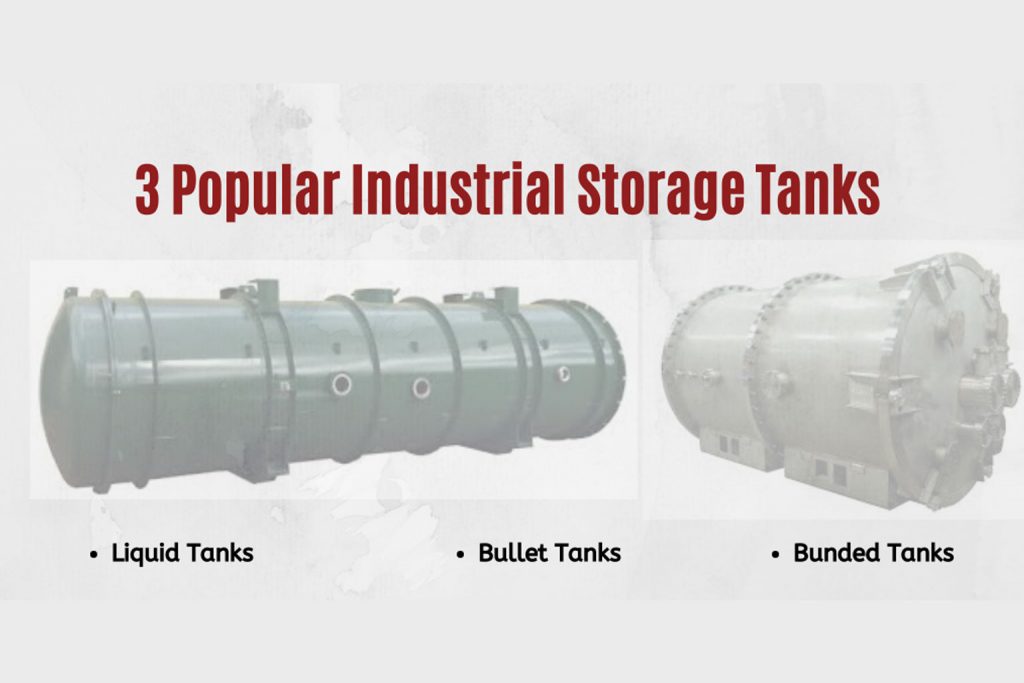Industrial storage tanks are designed to hold different types of liquids and gases at varying pressures and temperatures. They come in various shapes and are mounted both vertically and horizontally. These storage tanks are engineered under ASME Section VIII Div II regulations and are made of superior quality materials that assure their safety and performance. There are different types of storage tanks used across industries, which are chosen on the basis of storage capacities, measurements, shape of containers, and so on. Are you intrigued to know about the different types of industrial storage tanks used today? This post discusses three important types of storage tanks across different industries.
Main Types of Industrial Fuel Storage Tanks
Storage tanks are mainly differentiated as underground and aboveground tanks based on their positioning on the ground. They can be described as below:
- Underground Fuel Storage Tanks: These tanks are buried under the ground. Although they are buried fully, 10% of their volume remains under the ground. The tanks are usually designed for storing extremely hazardous fuels or materials. Underground fuel storage tanks reduce the chances of accidents due to explosion, but their main drawback is inaccessibility.
- Aboveground Fuel Storage Tanks: These tanks are installed above the ground and ideal for storing water, chemicals and fuels. Most industrial storage tanks are of this type owing to their low upfront costs and ease of maintenance.
The tanks described in the below section are built for aboveground or underground storage.
3 Commonly Used Industrial Storage Tanks
Industrial storage tanks are available in a variety of specifications. They are described on the basis of their storage purpose, design, placement, and the material used for construction. Here are a few popular ones based on different criteria:
-
- Liquid Tanks:As the name suggests, these tanks are designed for storing volatile and non-volatile liquids. These tanks are designed with robust materials to withstand corrosion and other harsh environment conditions. The following are two popular types of liquid tanks used today:
- Glycol Storage Tanks: Ethylene glycol is a non-corrosive chemical, and is an integral part of several industrial processing activities. This chemical is stored in tanks made of stainless steel or carbon steel. Sometimes, double wall tanks are used for glycol storage to ensure safety.
- Ammonia Storage Tanks: Ammonia is a dangerous and corrosive chemical and requires more safety storage than glycol. Industrial storage tanks used for ammonia storage are designed to meet the guidelines of ASME Boiler and Pressure Vessel Code. These tanks are usually provided with safety driven features such as external flow valves and internal valves.
- Bullet Tanks: These industrial storage tanks resemble a bullet, with their cylindrical construction, and are mainly preferred for bulk storage in large plants. Over the other types of industrial tanks, bullets tanks are mainly preferred for storing low melting points liquefied gases such as Butane and Ammonia. They can hold a huge quantity of gases under a temperature below -148 degrees Fahrenheit. Additionally, they can also hold fuel and other additives required for the plant’s operation.
- Bunded Tanks: These storage tanks possess a secondary containment tank in its outer side. The outer tanks act as a catch system for preventing oil spills. This strong and protective layer contributes to the robustness of the tank.
- Liquid Tanks:As the name suggests, these tanks are designed for storing volatile and non-volatile liquids. These tanks are designed with robust materials to withstand corrosion and other harsh environment conditions. The following are two popular types of liquid tanks used today:
Today, different types of storage tanks are used across plants, as they are capable of holding sensitive gases and liquids. These tanks may fail due to several reasons ranging from mishandling of the tank or the low-quality material used for construction or due to welding discrepancies. To avoid dangerous consequences, it is important to partner with an experienced manufacturer who guarantees safety and performance. BEPeterson is one such company that takes care of all significant safety hazards when designing industrial storage tanks. The company specializes in ASME and non-ASME pressure vessels, and has been delivering quality-driven and safety-oriented industrial storage tanks since its inception. Tanks can also be designed and fabricated to meet Canadian CRN and European PED requirements.

